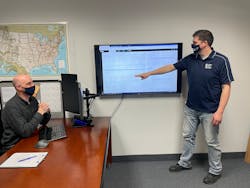2021 IW Best Plants Winner: IPG Tremonton Wraps Up a Repeat IW Best Plants Win
With low-hanging fruit, accomplishing great strides can be relatively easy. That was the case for the Intertape Polymer Group plant in Tremonton, Utah, back in 2013, when the infusion of an “automotive mentality” prioritized continuous improvement best practices.
The successes were regular and meaningful. By 2017, the once struggling facility earned an IndustryWeek Best Plants Awards designation – not an easy feat by any means, and welcome recognition for all the efforts put forth in pursuit of excellence.
Fast forward to today, and the manufacturer of shrink wrap, stretch wrap and shipping air pillows has moved up another notch, once again positioned amongst North America’s manufacturing elite.
Making the Jump
Embarking on a digital transformation played a monumental role in reaching the next level. The operations team embraced the opportunity to be one of the first facilities within the IPG family of production plants to pilot a host of new technologies from analytics to 3D printers.
One notable success includes replacing “tribal knowledge” with data analytics to consistently address yield management on a crucial component of its shrink wrap production line.
Has transformation been easy? No. Did they suffer through hiccups along the way? Absolutely. Has the plant reached its ultimate goals? Not even close.
“But it has been fun,” explains operations manager Bill Bourgeous, adding that the Tremonton team had the unique opportunity to explore new avenues and improve their operations with the full support of the corporate transformation team.
“In many ways, we were entering into unknown territory, serving as trailblazers and ultimately setting expectations for our sister plants,” says Bourgeous. “While we had goals, the company did not know if the investments would prove fruitful.”
Of course, uncertainty didn’t mean the pressure to succeed was nonexistent. After all, the company was still making significant investments. “They had an out, I would pull the plug,” says Jai Sundararaman, IPG vice president of business transformation. “They were having no part of it.”
Simple Improvements Count, Too
All wins – big and little – have added to Tremonton’s continued success, including improvements made through what IPG calls “Simple Improvements.”
Tremonton’s Erik Richardson, continuous improvement and quality control manager, shed light on some of IPG’s best practices, revealing the mileage IPG Tremonton has gotten out of making small improvements.
Outside of digital transformation, floor employees are encouraged to submit input on the workplace through the company’s Simple Improvements program. In one case, a worker noticed a potential hazard and took the initiative to fix it.
“We had a spot in the facility where an employee could walk between machinery” in a way that could have proven dangerous for an unwary worker, Richardson explains. An employee who worked in that area of the plant installed a safety chain, took before and after photos, and submitted the fix to management.
“It’s actually increased the workflow within that one department,” says Richardson. IPG maintains a wall cataloguing dozens of similar improvements, which range from safety chains to repainted lines or labels on tool-storage racks.
As extra incentive to submit improvements, IPG Tremonton has department managers pick their favorite project on a quarterly basis and award the person behind it a $250 cash prize. “We sifted and filtered everything down to the smallest common denominator,” says Richardson, noting the process is even simpler than submitting an A3.
“It does a couple of things for us where some of our newer employees get the opportunity to make a name for themselves,” Richardson says. “Many people don’t really care about the money, or they don’t care about winning an award, they just like to be told, ‘You’re doing a good job.’ For them to be able to just get that opportunity to say, ‘Hey, you know what I’m doing here, too.’”
Read more about the IW Best Plants Awards
IPG Tremonton’s wins in digital transformation somewhat reflect its Simple Improvements system, as small steps in digitization can lead towards unexpectedly profound results.
One of IPG’s main product lines is thin plastic wrap—the kind used to wrap pallets or products on shelves. IPG Tremonton has two machines that take liquid plastic, blow it into tubes and then cut it on each side to make two sheets of flat plastic wrap.
“If you wrapped it and just wound it straight, it would look like a record, with peaks and valleys,” says Richardson. So instead, the machines rotate horizontally, like two cans of pop on turntables. Initially, IPG used a gauge that indicated whether the film was too thick or too thin. “That was OK,” says Richardson, “but it didn’t get us the information we needed.”
Working with an outside company, IPG Tremonton upgraded the gauge to one that could quantify the thickness of the cut plastic in real time as the machine operates.
The benefits of the tinkering were twofold. First, the upgrade gave operators the ability to correct deviations on the fly. Second, “we found that we had some variations between a couple of our machines,” Richardson says. Using the new gauge on both machines revealed that one of them was producing film “a few percentage points thicker” than its twin. “We [were] basically giving away free product,” Richardson recalled. The new sensor gave IPG the information it needed to label film more accurately.
Leadership Sets the Tone
Initially, IPG approached digital transformation as more of a discovery process, explains Sundararaman. "When I looked at my 27 plants, there were a few criteria that helped determine who's going to be the pilot. I chose Tremonton primarily because it filled multiple criteria."
One crucial criterion was the strength and skills of the local leadership team, which at the time included former operations leader Bryan Garfield (who is now on Sundararaman’s team), Bourgeous and Richardson.
"They played a big role in capitalizing on the technology and moving the Tremonton plant further ahead," says Sundararaman. "These guys were already very good at what they do, but they were plateauing. The problem-solving capabilities and mindset were already in place, but they hit a threshold in terms of numbers."
While the corporate team was dedicated to fully supporting the plant, the local leaders needed to be dedicated to running the pilot, on top of their day job.
“It was a two-and-a-half-year exercise with multiple platforms, but now we are scaling,” says Sundararaman. “On a transformation of this nature, you don't have a playbook. You have to customize it for the individual operation’s needs, as well as the culture of the company.”
Molding the Digital Leader
Bourgeous, who was engineering manager when the plant started its transformation, is what Sundararaman refers to as his first digital leader.
“To me digital leadership is a merging of lean, Six Sigma and TPS with today’s tools to amplify leadership and provide more velocity,” Bourgeous says. “Rather than paper-based checklists and A3s written in pencil, we're working to digitize everything. As a digital leader, it’s important to have vision to implement these things digitally, to take the risks, to deal with the pains that come with changing how things are done.”
The Road Ahead
With a goal of developing more digital leaders, IPG is introducing a digital academy to focus on the needed skillsets and help plants more methodically address the various dimensions of transformation (i.e., big data analytics, process insights and emerging technologies like AR/VR, cobots and additive manufacturing).
“The key will be identifying the different levels of users from beginners to power users, and then providing the framework needed for the team to succeed,” says Sundararaman. “As we scale this to other plants, we are offering them a carrot and stick. If they want improvements or enhancement, I'm here to provide, assuming they are able to hit the milestones.”
The first phase of the digital transformation at Tremonton has revolved around production machinery, production systems and process engineering. “Now we're pushing forward the human side,” says Bourgeous. “Which includes revamping our work instructions, document management and employee feedback and using whatever best technologies are available to improve each process.”







